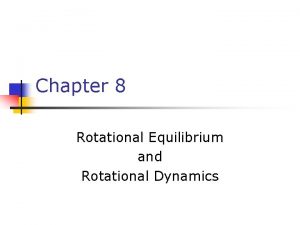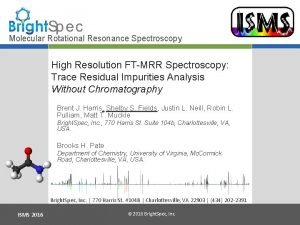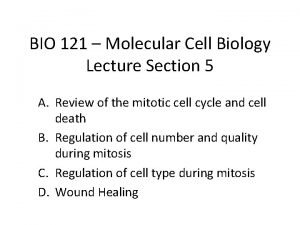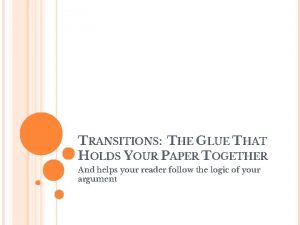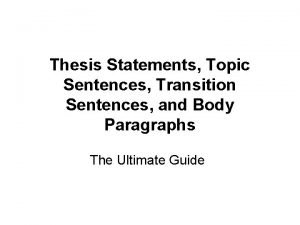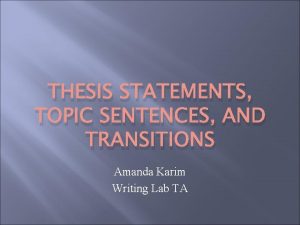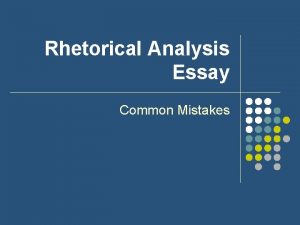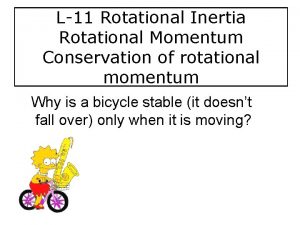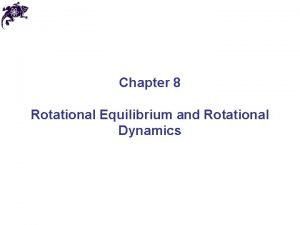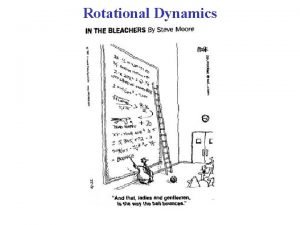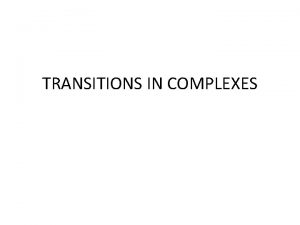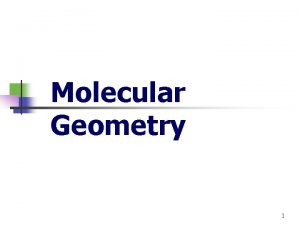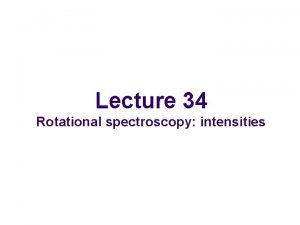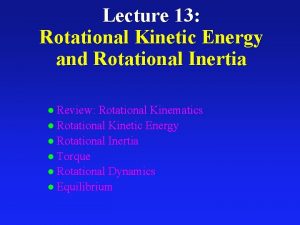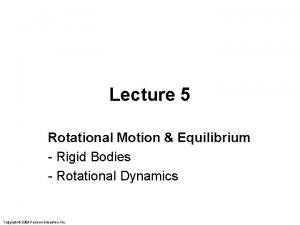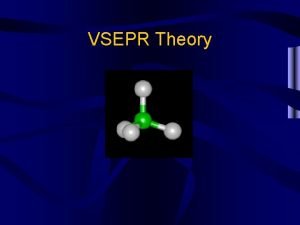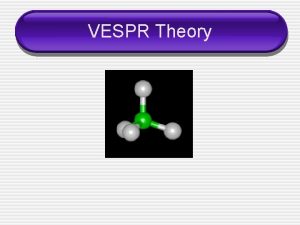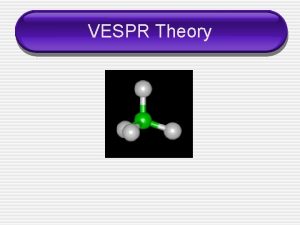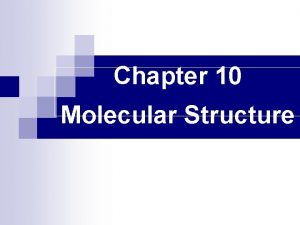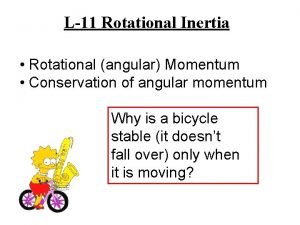Lecture 14 Molecular structure o Rotational transitions o

















- Slides: 17

Lecture 14: Molecular structure o Rotational transitions o Vibrational transitions o Electronic transitions PY 3 P 05

Bohn-Oppenheimer Approximation o Born-Oppenheimer Approximation is the assumption that the electronic motion and the nuclear motion in molecules can be separated. o This leads to molecular wavefunctions that are given in terms of the electron positions (ri) and the nuclear positions (Rj): o Involves the following assumptions: o Electronic wavefunction depends on nuclear positions but not upon their velocities, i. e. , the nuclear motion is so much slower than electron motion that they can be considered to be fixed. o The nuclear motion (e. g. , rotation, vibration) sees a smeared out potential from the fastmoving electrons. PY 3 P 05

Molecular spectroscopy o Electronic transitions: UV-visible o Vibrational transitions: IR o Rotational transitions: Radio E Electronic Vibrational Rotational PY 3 P 05

Rotational motion o Must first consider molecular moment of inertia: o At right, there are three identical atoms bonded to “B” atom and three different atoms attached to “C”. o Generally specified about three axes: Ia, Ib, Ic. o For linear molecules, the moment of inertia about the internuclear axis is zero. o See Physical Chemistry by Atkins. PY 3 P 05

Rotational motion o Rotation of molecules are considered to be rigid rotors. o Rigid rotors can be classified into four types: o Spherical rotors: have equal moments of intertia (e. g. , CH 4, SF 6). o Symmetric rotors: have two equal moments of inertial (e. g. , NH 3). o Linear rotors: have one moment of inertia equal to zero (e. g. , CO 2, HCl). o Asymmetric rotors: have three different moments of inertia (e. g. , H 2 O). PY 3 P 05

Quantized rotational energy levels o The classical expression for the energy of a rotating body is: where a is the angular velocity in radians/sec. o For rotation about three axes: o In terms of angular momentum (J = I ): o We know from QM that AM is quantized: , J = 0, 1, 2, … o Therefore, , J = 0, 1, 2, … PY 3 P 05

Quantized rotational energy levels o Last equation gives a ladder of energy levels. o Normally expressed in terms of the rotational constant, which is defined by: o Therefore, in terms of a rotational term: cm-1 o The separation between adjacent levels is therefore F(J) - F(J-1) = 2 BJ o As B decreases with increasing I =>large molecules have closely spaced energy levels. PY 3 P 05

Rotational spectra selection rules o Transitions are only allowed according to selection rule for angular momentum: J = ± 1 o Figure at right shows rotational energy levels transitions and the resulting spectrum for a linear rotor. o Note, the intensity of each line reflects the populations of the initial level in each case. PY 3 P 05

Molecular vibrations o Consider simple case of a vibrating diatomic molecule, where restoring force is proportional to displacement (F = -kx). Potential energy is therefore V = 1/2 kx 2 o Can write the corresponding Schrodinger equation as where o The SE results in allowed energies v = 0, 1, 2, … PY 3 P 05

Molecular vibrations o The vibrational terms of a molecule can therefore be given by o Note, the force constant is a measure of the curvature of the potential energy close to the equilibrium extension of the bond. o A strongly confining well (one with steep sides, a stiff bond) corresponds to high values of k. PY 3 P 05

Molecular vibrations o The lowest vibrational transitions of diatomic molecules approximate the quantum harmonic oscillator and can be used to imply the bond force constants for small oscillations. o Transition occur for v = ± 1 o This potential does not apply to energies close to dissociation energy. o In fact, parabolic potential does not allow molecular dissociation. o Therefore oscillator. more consider anharmonic PY 3 P 05

Anharmonic oscillator o A molecular potential energy curve can be approximated by a parabola near the bottom of the well. The parabolic potential leads to harmonic oscillations. o At high excitation energies the parabolic approximation is poor (the true potential is less confining), and does not apply near the dissociation limit. o Must therefore use a asymmetric potential. E. g. , The Morse potential: where De is the depth of the potential minimum and PY 3 P 05

Anharmonic oscillator o The Schrödinger equation can be solved for the Morse potential, giving permitted energy levels: where xe is the anharmonicity constant: o The second term in the expression for G increases with v => levels converge at high quantum numbers. o The number of vibrational levels for a Morse oscillator is finite: v = 0, 1, 2, …, vmax PY 3 P 05

Vibrational-rotational spectroscopy o Molecules vibrate and rotate at the same time => S(v, J) = G(v) + F(J) o Selection rules obtained by combining rotational selection rule ΔJ = ± 1 with vibrational rule Δv = ± 1. o When vibrational transitions of the form v + 1 v occurs, ΔJ = ± 1. o Transitions with ΔJ = -1 are called the P branch: o Transitions with ΔJ = +1 are called the R branch: o Q branch are all transitions with ΔJ = 0 PY 3 P 05

Vibrational-rotational spectroscopy o Molecular vibration spectra consist of bands of lines in IR region of EM spectrum (100 – 4000 cm-1 0. 01 to 0. 5 e. V). o Vibrational transitions accompanied by rotational transitions. Transition must produce a changing electric dipole moment (IR spectroscopy). Q branch P branch R branch PY 3 P 05

Electronic transitions occur between molecular orbitals. o Must adhere to angular momentum selection rules. o Molecular orbitals are labeled, , … (analogous to S, P, D, … for atoms) o o For atoms, L = 0 => S, L = 1 => P For molecules, = 0 => , = 1 => o Selection rules are thus = 0, 1, S = 0, =0, = 0, 1 o Where = + is the total angular momentum (orbit and spin). PY 3 P 05

The End! o All notes and tutorial set available from http: //www. physics. tcd. ie/people/peter. gallagher/lectures/py 3004/ o Questions? Contact: o peter. gallagher@tcd. ie o Room 3. 17 A in SNIAM PY 3 P 05
 Covalent bond
Covalent bond Ionic covalent metallic
Ionic covalent metallic Giant molecular structure vs simple molecular structure
Giant molecular structure vs simple molecular structure Rotational equilibrium example problems
Rotational equilibrium example problems Rotational equilibrium and rotational dynamics
Rotational equilibrium and rotational dynamics Molecular rotational resonance
Molecular rotational resonance Transition words for text structures
Transition words for text structures 01:640:244 lecture notes - lecture 15: plat, idah, farad
01:640:244 lecture notes - lecture 15: plat, idah, farad Molecular biology lecture
Molecular biology lecture Molecular cell biology lecture
Molecular cell biology lecture Fibroblast
Fibroblast Windows live movie maker add music
Windows live movie maker add music Conclusion transitions
Conclusion transitions Transition and topic sentence
Transition and topic sentence Example of thesis statement and topic sentence
Example of thesis statement and topic sentence Script writing elements
Script writing elements Modern project profiles in spm
Modern project profiles in spm Transitions for rhetorical analysis
Transitions for rhetorical analysis



